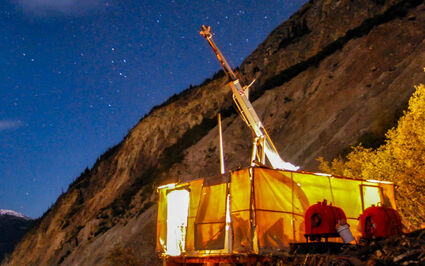Iron Cap block cave mine bolsters KSM
PEA demonstrates financial and environmental advantages North of 60 Mining News – May 1, 2020
Last updated 9/26/2020 at 2:20pm

Kevin Burt, Seabridge Gold Inc.
Drilling at KSM has outlined roughly 106 million ounces of gold, 46 billion pounds of copper and 614 million oz of silver.
An updated preliminary economic assessment for Seabridge Gold Inc.'s KSM project provides a first look at the economic and environmental advantages of incorporating the recently expanded, higher grade Iron Cap gold-copper deposit into the mine plan.
"The benefits of incorporating Iron Cap into mine plans at an early stage have exceeded the upper end of our expectations, not only for the improvements in projected economics but also for the reduction in environmental impact," said Seabridge Gold Chairman and CEO Rudi Fronk.
The 2020 PEA envisions a combined open pit and underground block cave mining operation feeding a 170,000-metric-ton-per-day processing facility that would produce 27.6 million ounces gold and 17 billion pounds copper over a 44-year mine life, or roughly an average of 627,000 oz of gold and 386.4 million lb of copper per year.
And this mine only considers mining about a third of the total resources that have been outlined at KSM.
Over the first five years, this operation is expected to produce 1.3 million oz gold and 265 million pounds of copper annually, generating US$1.45 billion of pre-tax free cash flow per year.
At this rate, it would only take four years to pay the US$5.2 billion of initial capital needed to develop this mine.
The average total cost for each ounce of gold produced over the life of the mine is expected to only be US$4, after crediting the revenues from the copper and silver also produced.
As a result, the after-tax net present value (5% discount) of the mine outlined in the PEA is US$6 billion.
The base case financials were calculated using average price assumptions of US$1,340/oz gold, US$2.80/lb copper and foreign exchange rate of US76 cents per C$1.00.
"These PEA economic projections, if achieved, would rank KSM among the best large-scale producing mines in the world," Fronk said.
The operation outlined in the PEA also brings the added environmental benefits of 57% reduction in mine waste rock and 33% less greenhouse gas emissions than the mine operations detailed in a 2016 pre-feasibility study and approved through the federal and provincial Environmental Assessment processes.
The primary reason for these economic improvements is because underground mining accounts for roughly two-thirds of the production in the 2020 PEA, with the balance coming from open-pit mines. This is the opposite of the 2016 PFS, which had about two-thirds of its ore coming from open-pit and the rest from underground.
Electrification of the Iron Cap underground block cave mine equipment with partial automation results in significant reduction in diesel consumption reduction, which would be replaced by lower cost green power supplied by BC Hydro. The increased initial costs to acquire the electrified and semi-automated equipment would be offset by lower operating costs.
According to Seabridge, the PEA does not preclude the operation outlined in the 2016 PFS. Instead, it serves as a side-by-side alternative that provides investors and potential partners a first look at a scenario that incorporates a block cave mine at Iron Cap.
"The PEA is based on Iron Cap's inferred resource estimate, but we are very confident these resources will upgrade to higher categories with further drilling as they have in the past at the project's other deposits," Fronk said. "We therefore think the new technical report gives investors a compelling view of the project's potential."
Seabridge engaged independent consultants to conduct an extensive data verification exercise on the 2016 PFS to determine whether there had been any material changes to the information used in the 2016 PFS and whether the study could be considered current. The results of this exercise verified that if the 2016 PFS were to be updated using the 2020 information, there would be no material change to outcomes of the 2016 PFS, its capital and operating costs, mineral reserves, or financial analysis, and therefore the 2016 PFS remains current and is suitable to be used unchanged in the 2020 technical report.

Seabridge Gold Inc.
Logging core from 2018 drilling at KSM, a program that expanded the higher grade underground copper-gold resource at Iron Cap.
According to a 2019 resource calculation that includes an expansion of Iron Cap, KSM hosts 2.98 billion metric tons of measured and indicated resources averaging 0.52 grams per metric ton (49.7 million ounces) gold, 0.21% (13.9 billion pounds) copper, 2.8 g/t (265 million oz) silver and 54 parts per million (312 million lb) molybdenum; plus 4.56 billion metric tons of inferred resource averaging 0.38 g/t (56.3 million oz) gold, 0.32% (32 billion lb) copper, 2.4 g/t (349 million oz) silver and 32 ppm (295 million lb) molybdenum.
More information on Iron Cap and the KSM project can be read at Mission Accomplished – KSM partner ready in the 2019 edition of Mining Explorers, an annual magazine published by North of 60 Mining News.















Reader Comments(0)